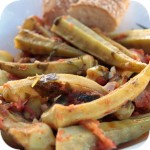

We will not cheat you. Imam Bayildi is not a diet and it should not be like that. A large amount of oil is needed here to produce a delicious sauce, in which the eggplant will almost swim. We also ate such a delicious "floating" Imam in Matala, Crete, and he was the prototype for our recipe. Unfortunately, most of the polonized recipes for this dish try to slim it down, ignoring the issue of a sufficiently large amount of oil. This shows that their authors have never tried this dish in Greece.
We will not discuss how the dish was invented in the country, Greece or Turkey. It is known that for many centuries both cultures have permeated each other, and Imam Bayildi exists in the kitchens of both these nations to this day and is prepared in a very similar way.
Probably many people will consider a rather unusual name of this dish, which is related to the history of its creation. Well, eggplants were the favorite vegetable of a Turkish Imam. Therefore, his wife / lover / sister / mother / hostess (option depending on the history transferred) constantly developed new recipes using aubergines. One day she served to the Imam this dish which, after ingestion, caused him to faint. Unfortunately, we will never know why this imam swooned. But on this subject a few speculations arose. The first one says that the fainting occurred due to the sophisticated taste of the dish. The second was that the dish was too much of a burden to the stomach of a poor imam who simply missed himself. The third version - for a skner - says that the stingy imam fell into shock when he learned how much precious oil was used to prepare this dish. And perhaps all three reasons have contributed a little to the state of fainting.
One thing is for sure Imam Bayildi is the best with fresh bread, which you can choose all delicious sauce.
1. Cut eggplants along and then twice across while taking care not to cut the skin on the other side. Cut into salt in the incisions and leave for about half an hour. After this time, rinse the aubergines under water and dry thoroughly with a paper towel.
2. Warm up a small amount of oil in the pan and fry the eggplant from each side until they start to soften. Their skin should change to a more brown color. Then remove them from the pan and put them into a deep, heat-resistant dish.
3. Pour a little olive oil over the same pan and fry onions and garlic. When the onion is slightly golden, add one finely chopped tomato, honey, parsley and season with salt and pepper to taste. Fry a few minutes until the excess water evaporates and the flavors are combined.
4. We fill the cuts in aubergines with the previously prepared stuffing, while on the top we put the tomato cut into slices. The whole is sprinkled with lemon juice.
5. To the dish in which the eggplants will be baked, pour the rest of the oil we left, add the tomatoes and cover them tightly with aluminum foil. Bake at 170 degrees for about 40 minutes. After this time, the aubergines should be soft and ready to serve.
Καλή όρεξη!


Eggplants are a popular ingredient of Greek dishes and can be found in flagship dishes such as moussaka or briam. The main role of aubergines also play in papoutsakia, imam bayildi and melitzanosalata. For these tasty dishes you need to add another Greek way to make this vegetable, or eggplant with feta.

The popular vegetable in Crete is okra, which can often be found in local greengrocers. This very healthy and low-calorie vegetable is unfortunately virtually unheard of in Poland. If you would like to try it, it's worth doing it while in Crete. Just look for one of the local taverns, which serves dishes prepared on the basis of okra. Of course, you can also prepare it yourself, for example based on the following recipe.

Vegetable pancakes are a specialty of Greek cuisine. The multitude of vegetables available at any time of the year provokes even the ingenious use of them. Tomatokeftedes, or tomato pies, is the recipe that proves this theory. This dish is popular on the Cyclades and in the traditional cuisine of Syros, Andros, Tinos or Santorini. The most characteristic taste of tomatokeftedes is reached by the inhabitants of the latter island due to the specific taste of small tomatoes growing there.
Komentarze
komentarz z
wszystkie imamy po prostu uwielbiamy :D
komentarz z
Julita Kulikowska-Mak, zrobiłaś już? ;-)
komentarz z
Krzysztof Kania przecież byś zjadł gdybym zrobiła, obiecałam
komentarz z
Danie to poznałam będąc w Turcji...bardzo mi smakuje i czasem je robię ☺
komentarz z
My najlepszego imama jedliśmy właśnie na Krecie. Tam właśnie podpatrzyliśmy ten sposób przyrządzania go.
komentarz z
Podczas następnego pobytu tam,będę musiała go spróbować...jestem pewna że będzie smakować jeszcze lepiej
komentarz z
U mnie na Krecie są fajniejsze fajniejsze dania ,a ten owoc ( podobno ) ma duzo do zaoferowania ....
Wypełnij poniższy formularz aby dodać komentarz
lub kliknij w poniższy link aby skorzystać z możliwosci komentowania przez facebooka:
https://www.facebook.com/crete.poland/posts/10153098734027551,10155528280677551